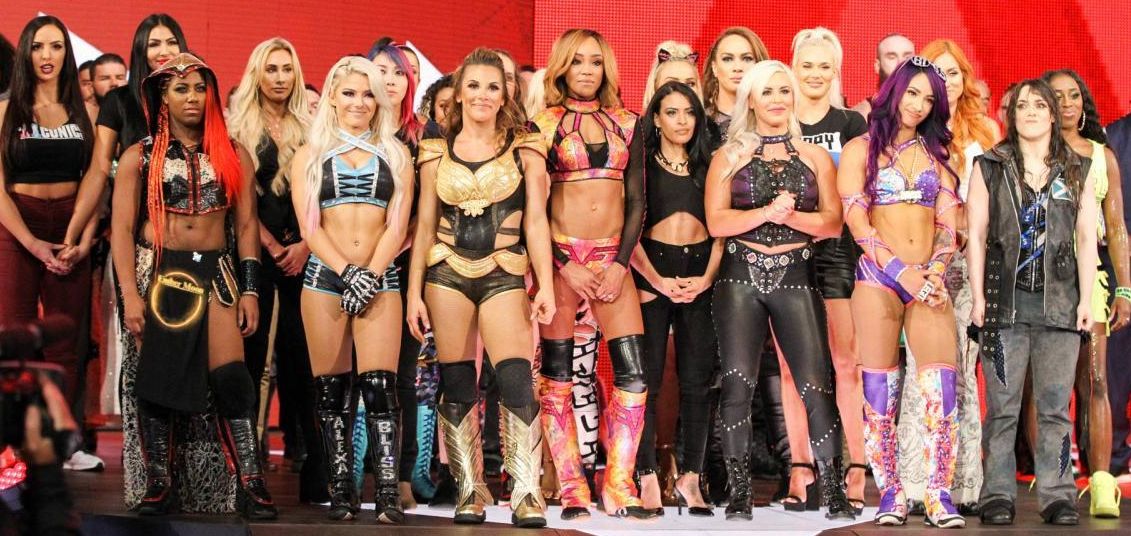 ★★★½
★★★½
“The truth about the Evolution”
The WWE has had a fraught relationship with women’s wrestling over the years, but things seem to have been heading in a positive direction recently. They dropped the terrible “Divas” tag, renaming the belt back to being the women’s championship, and with Triple-H overseeing things, seemed to be bringing in talent based on wrestling ability, rather than just looks. While very much a work in progress, this led to ground being broken on October 28, with the company holding its first-ever pay-per-view show entirely filled with women’s matches. That there was enough talent to make such a show possible, in itself indicated how things had changed. However, it was not without controversy.
The event itself was announced in July, and may have been a reaction to criticism of WWE after their April Greatest Royal Rumble show in Saudi Arabia. Due to that country’s social climate, women were not allowed to wrestle there, and after a promo video included them in action, the Saudi General Sports Authority issued an apology for this “indecent material.” Having a women-only PPV seemed like an acknowledgement of the issues. Yet Evolution was overshadowed by another WWE event in Saudi Arabia, scheduled a week later – a situation not helped by the murder of local journalist Jamal Khashoggi at the country’s consulate in Istanbul. The concept also came in for criticism from those who felt the company was patting itself on the back for “evolving” out of depths which were entirely of Vince McMahon’s own making.
I can’t honestly say these factors had any impact on my interest in the largest women’s show ever – at least, in the United States. For back in 1994, AJW held their oddly-named Big Egg Wrestling Universe show at the Tokyo Dome, with a crowd of over thirty thousand in attendance. In comparison, attendance at the Nassau Coliseum was less than one-third that, at 10,900. Still, it was an order of magnitude up on the previous American high, likely belonging to Impact Wrestling‘s One Night Only: Knockouts Knockdown show, which took place before a crowd of 1,100 in May 2014. And, for me, the possible positives heavily outweigh any negatives: a good show could encourage viewers to check out all-women federations like Shimmer or Shine. A rising tide floats all boats – I note a local Arizona federation staged its first gyno-centric show the weekend after Evolution.
 But would they deliver? Technically, it was a decent presentation by WWE, if a little smaller-scale than expected – the regular RAW set-up was elsewhere in the country, so they had to make do a bit in terms of lighting and spectacle. I did like the commentary team of Michael Cole, Beth Phoenix and Renee Young, who all seemed genuinely enthusiastic – even Cole, who can sometimes come over as a bit of a dick. With that said, let’s go through the seven matches on the official card (there was a ‘dark’ bout that took place before the broadcast began) and see how they fared. Spoilers. of necessity, follow the rest of the way.
But would they deliver? Technically, it was a decent presentation by WWE, if a little smaller-scale than expected – the regular RAW set-up was elsewhere in the country, so they had to make do a bit in terms of lighting and spectacle. I did like the commentary team of Michael Cole, Beth Phoenix and Renee Young, who all seemed genuinely enthusiastic – even Cole, who can sometimes come over as a bit of a dick. With that said, let’s go through the seven matches on the official card (there was a ‘dark’ bout that took place before the broadcast began) and see how they fared. Spoilers. of necessity, follow the rest of the way.
1. Trish Stratus and Lita defeated Mickie James and Alicia Fox. Things started slowly, as two retired Hall of Famers returned to kick the show off. Though James has been around almost as long, and fought against Stratus and Lita when they were active (both retired in 2006). This seemed intended as a bridge, to link the past to the present, but the fact the veterans had been out of ring action for more than a decade inevitably meant this was mostly slow and careful. Though the biggest botch belonged to Fox, whose save on a pinfall attempt was so late, the referee had to stop counting. The icons won after Lita hit her signature moonsault. She was the first woman I ever saw doing that move, and it’s still impressive [especially now at the age of 43!].
2. Nia Jax won by the 20-woman Battle Royal. Never been a big fan of the Battle Royal; it makes the ring look like a brawl on a rush-hour train in the early stages. Still, it was nice to see some more veterans, including Alundra Blayze, and Molly Holly, whom we interviewed in 2006. Iy did showcase the depth of women’s talent now present in the WWE. There were times in the past when I doubt they could have found 20 women in the company for a bout like this, without including make-up artists and secretaries. Things became less chaotic once we eventually got down to the final few competitors, and I was pleased to see Jax win. She’s one of the furthest from the archetypal “Diva” – billed at six foot tall and 273 pounds – yet unlike some of the larger men, is no slouch in the ring. Fun fact: her cousin is Dwayne “The Rock” Johnson.
3. Toni Storm defeated Io Shirai in the 2018 Mae Young Classic tournament final. The first singles match was an excellent one, despite being between two wrestlers not yet on the main roster. Both were familiar though: Storm had reached the semi-finals of the 2017 Mae Young Classic, while Shirai was part of one of our all-time favourite matches on Lucha Underground. Storm is an Australian, and could hardly be more archetypally Antipodean if she tried: tall, blond and fit. She’s going to be a star. For Shirai, the problem for WWE may be finding people of her level, against whom she can wrestle. I almost sensed her having to slow down and pull her punches here, to avoid overwhelming Storm. As with most Japanese wrestlers, the key to her success in the West will be if she can get her personality on the mic, something which has limited many of them in the past.
4. Sasha Banks, Bayley, and Natalya defeated The Riott Squad (Ruby Riott, Liv Morgan, and Sarah Logan). There’s nothing like a good bad girl, and the Riott Squad provides three of them. They certainly had my backing – but then, I’ve never been impressed by Banks, and for some reason, Bayley irritates me more than anything (I think it’s at least partly the hair). I thought the Squad worked particularly well as a team. If the rumblings about WWE introducing a women’s tag division prove true, then you could pick any two of the trio and they’d be more than credible contenders. Their opponents though? Meh. Largely forgettable, even Natalya, who typically represents good value for money.
5. Shayna Baszler defeated Kairi Sane for the NXT Women’s Championship. The two, shown below, have been feuding in NXT (the WWE’s top developmental brand), with former MMA fighter Baszler winning the title in April, but losing it to Sane in August. This was also a rematch of the final from the first Mae Young Classic, in which Sane prevailed over the “submission magician” Baszler – and was similar in content, with Bazler trying to ground and pound Sane, while the latter used her speed and agility to stay out of her opponent’s grasp. While Sane lost, it was largely only through the intervention of Baszler’s friends in the front-row, who helped her regain the title. That dubious interference helps solidify her heel status nicely, though she will need to do a better job of not seeming like Pepsi to Ronda Rousey’s Coke.

6. Becky Lynch defeated Charlotte Flair in a Last Woman Standing match for the WWE SmackDown Women’s Championship. This was pretty much a universal pick as match of the night: in Cageside Seats‘s poll, it got 86% of the votes, with nothing else at more than 4%. I can see why (though preferred Storm/Shirai). At almost half an hour long, it was epic in length: a stark contrast to the women’s match which started the #GiveDivasAChance trend on Twitter, and helped open the door for this show. That bout in 2015, pitted Paige & Emma against the Bella Twins, and lasted… 26 seconds. However, Lynch’s superior talent was often glaringly obvious, especially in the early stages, with Flair starting very slowly. She did improve as it went on, and this eventually blossomed into a full-on brawl, with kendo sticks and ladders used without mercy as weapons. It ended when Lynch powerbombed Flair through a table, and left her unable to beat the referee’s ten-count – the only way to win this match. It was certainly the fight that defined the event.
7. Ronda Rousey defeated Nikki Bella for the WWE Raw Women’s Championship. Our daughter went to school in Scottsdale with the Bella Twins. I’m sure she would have enjoyed seeing Nikki get the crap pounded out of her by “the most dangerous woman on the planet”. It was interesting how Nikki uses “diva” – WWE’s official designation for women wrestlers until April 2016 – as a term to get heel heat. In many ways, she is the last of that ‘old guard’, and to be honest, the sooner she’s gone the better, because she and her sister still can’t do more than take part in glorified catfights and make duck-faces. As such, Rousey is the anti-Bellas, and I’m fine with that. However, I’m unimpressed by WWE giving her the title, four months after her pro wrestling debut – at Wrestlemania. Considering the women who have honed their craft in obscurity for decades (hello, Mercedes Martinez), guess there’s still work to be done before WWE truly “gets” it.
All told, it was a solid event, especially considering it was the first of its kind. Yet if it is to be at all meaningful, it can’t be the last, and if WWE could avoid overshadowing it next time, simultaneously shooting itself in the foot, that would be just great… There won’t be quite the same novelty to promote Evolution II, yet that shouldn’t be a problem, as long as the weekly shows continue to provide a chance for the women to show their talents on a regular basis. It’s been a long time since I’ve been as optimistic about the potential future for women’s wrestling in the West, and despite the flaws, in future years we may look back to this event as a watershed in its blossoming.
Star: Ronda Rowsey, Nikki Bella, Becky Lynch, Charlotte Flair





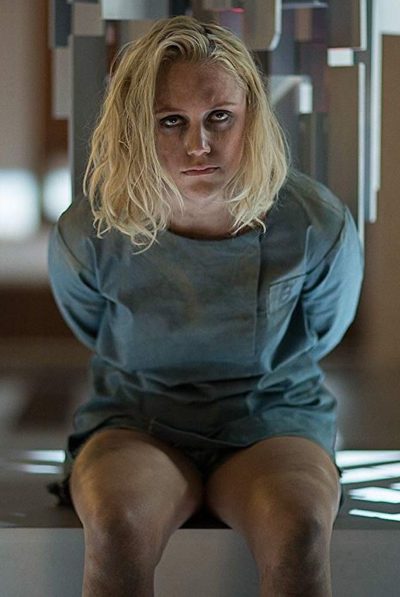 Julia (Monroe) is a petty thief, who is abducted from her house and wakes to find herself, along with other random low-lives, prisoner in a mysterious facility. All of them have an electronic implant in their neck, which gathers data as they are put through a series of tests. Using her thieving skills, Julia leads a breakout attempt, which is brutally foiled by the facility’s automated defense system, a robot called Aries. But the attempt brings her to the attention of Alex (Skrein), the man running the project. He’s a tech innovator, who has been working on a super-AI, called Tau (voiced by Oldman), and using the data gathered from his kidnapped subjects to make it smarter. Julia’s brain makes her particularly suitable, and with time running out before he has to present Tau to its backers, he sets her to work. But Julia begins building a relationship with Tau, with the aim of using its naivety to turn the AI against its cruel creator.
Julia (Monroe) is a petty thief, who is abducted from her house and wakes to find herself, along with other random low-lives, prisoner in a mysterious facility. All of them have an electronic implant in their neck, which gathers data as they are put through a series of tests. Using her thieving skills, Julia leads a breakout attempt, which is brutally foiled by the facility’s automated defense system, a robot called Aries. But the attempt brings her to the attention of Alex (Skrein), the man running the project. He’s a tech innovator, who has been working on a super-AI, called Tau (voiced by Oldman), and using the data gathered from his kidnapped subjects to make it smarter. Julia’s brain makes her particularly suitable, and with time running out before he has to present Tau to its backers, he sets her to work. But Julia begins building a relationship with Tau, with the aim of using its naivety to turn the AI against its cruel creator. ★★★
★★★ The film begins with an Argentinian school-trip to a volcanic area, which goes badly wrong when one of the schoolgirls, Cornelia, vanishes. Despite an extensive search, all that’s found is her locket. 14 years later, the missing girl’s best friend, Pipa (Lopilato), is now a cop, channeling the guilt she still feels about Cornelia’s disappearance and her role in it, into work. After a mass to mark the anniversary of the incident, Cornelia’s mother visits Pipa, begging her to re-open the case. Despite initial qualms, she does so, only to find a restaurant-sized can of worms comes along with it. Pipa finds herself facing a serious criminal organization, under the control of a woman known as The Mermaid (Salamanca), whose tentacles stretch both around the world and into the past.
The film begins with an Argentinian school-trip to a volcanic area, which goes badly wrong when one of the schoolgirls, Cornelia, vanishes. Despite an extensive search, all that’s found is her locket. 14 years later, the missing girl’s best friend, Pipa (Lopilato), is now a cop, channeling the guilt she still feels about Cornelia’s disappearance and her role in it, into work. After a mass to mark the anniversary of the incident, Cornelia’s mother visits Pipa, begging her to re-open the case. Despite initial qualms, she does so, only to find a restaurant-sized can of worms comes along with it. Pipa finds herself facing a serious criminal organization, under the control of a woman known as The Mermaid (Salamanca), whose tentacles stretch both around the world and into the past. We arrived here with Teresa Mendoza (Braga) having gunned down Don Epifanio, and made an implacable enemy of his estranged wife, Camila Vargas (Falcon). Epifanio had become the Governor of Sinaloa, a position Camila took over, using it to buttress her position at the top. She formed alliances on both sides to assist her further: notably General Cortez (Arias), who provided military muscle, and with DEA agent Alonzo Loya, to whom she fed intelligence about her rivals. However, Camila’s increasingly strained relationship with her teenage daughter ends up being used against her.
We arrived here with Teresa Mendoza (Braga) having gunned down Don Epifanio, and made an implacable enemy of his estranged wife, Camila Vargas (Falcon). Epifanio had become the Governor of Sinaloa, a position Camila took over, using it to buttress her position at the top. She formed alliances on both sides to assist her further: notably General Cortez (Arias), who provided military muscle, and with DEA agent Alonzo Loya, to whom she fed intelligence about her rivals. However, Camila’s increasingly strained relationship with her teenage daughter ends up being used against her.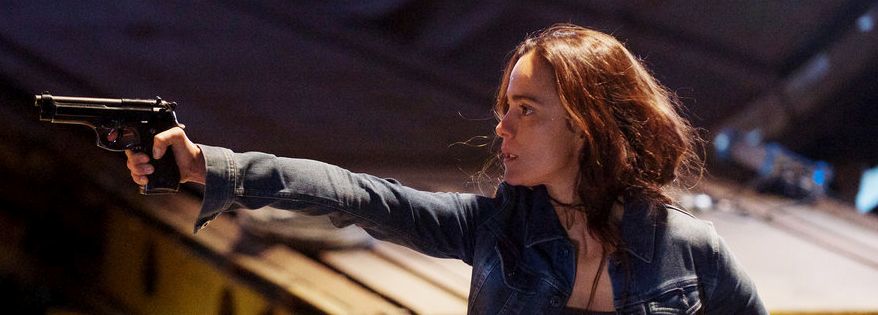
 I have not seen any of the entries on the male side of the Ocean’s franchise, so can’t say how this compares. Maybe it would have helped – I sense there were efforts to tie them together, with a pic of George Clooney (whom I assume played the late brother of Bullock’s character). Maybe it would have hindered – even with my ignorance of the series, the heist movie we get here seems more than slightly familiar. The obvious touchstone here is the gender reversal of Ghostbusters, though while that was a reboot of the franchise, this is just another entry. Female-led, to be sure, but part of the universe, rather than writing over it. Perhaps that explains why this didn’t receive a fraction of the backlash; the lack of any significant, pre-existing rabid Ocean’s fanbase is perhaps also a factor.
I have not seen any of the entries on the male side of the Ocean’s franchise, so can’t say how this compares. Maybe it would have helped – I sense there were efforts to tie them together, with a pic of George Clooney (whom I assume played the late brother of Bullock’s character). Maybe it would have hindered – even with my ignorance of the series, the heist movie we get here seems more than slightly familiar. The obvious touchstone here is the gender reversal of Ghostbusters, though while that was a reboot of the franchise, this is just another entry. Female-led, to be sure, but part of the universe, rather than writing over it. Perhaps that explains why this didn’t receive a fraction of the backlash; the lack of any significant, pre-existing rabid Ocean’s fanbase is perhaps also a factor.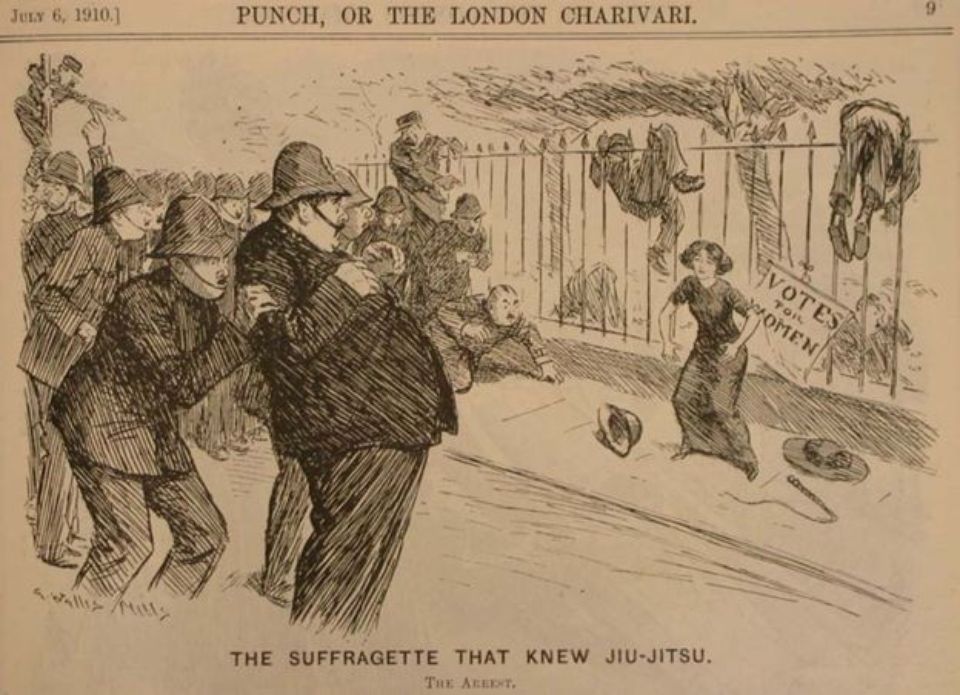
 I don’t typically binge-watch shows, being generally content with an episode or two per week. For the second season of GLOW, Netflix’s original series (very) loosely based on 80’s TV show Gorgeous Ladies of Wrestling, we made an exception and blitzed through the series in a couple of days. This in itself is a recommendation – with most of the episodes running barely 30 minutes, it was very much a case of “just one more…” Before we knew it, we were done, and left with a vague feeling of emptiness and slight regret at having burned the 10 episodes so quickly.
I don’t typically binge-watch shows, being generally content with an episode or two per week. For the second season of GLOW, Netflix’s original series (very) loosely based on 80’s TV show Gorgeous Ladies of Wrestling, we made an exception and blitzed through the series in a couple of days. This in itself is a recommendation – with most of the episodes running barely 30 minutes, it was very much a case of “just one more…” Before we knew it, we were done, and left with a vague feeling of emptiness and slight regret at having burned the 10 episodes so quickly.
 The Hyde Project was a secret government experiment to create artificially-enhanced super-soldiers. Due to difficulty controlling their aggressive tendencies, it shut up shop, but not before 13 of them escaped. They are now being hunted down by a pair of MI-6 agents, Damion Crow (Kyle Hotz) and Lina Petrov (Jensen). Connected to this, somehow, is Iris Black (Newberry). She’s a put-upon barista, with a cheating boyfriend, sleazy boss, alleged stalker – and an increasing body-count of the people around her, the corpses being tagged with religious symbols, in line with the work of an active serial killer. This quickly brings her to the attention of the FBI, in particular Agent Fry (Osborne) and her partner, who have been hunting the killer. They’re not exactly prepared for what they will discover.
The Hyde Project was a secret government experiment to create artificially-enhanced super-soldiers. Due to difficulty controlling their aggressive tendencies, it shut up shop, but not before 13 of them escaped. They are now being hunted down by a pair of MI-6 agents, Damion Crow (Kyle Hotz) and Lina Petrov (Jensen). Connected to this, somehow, is Iris Black (Newberry). She’s a put-upon barista, with a cheating boyfriend, sleazy boss, alleged stalker – and an increasing body-count of the people around her, the corpses being tagged with religious symbols, in line with the work of an active serial killer. This quickly brings her to the attention of the FBI, in particular Agent Fry (Osborne) and her partner, who have been hunting the killer. They’re not exactly prepared for what they will discover.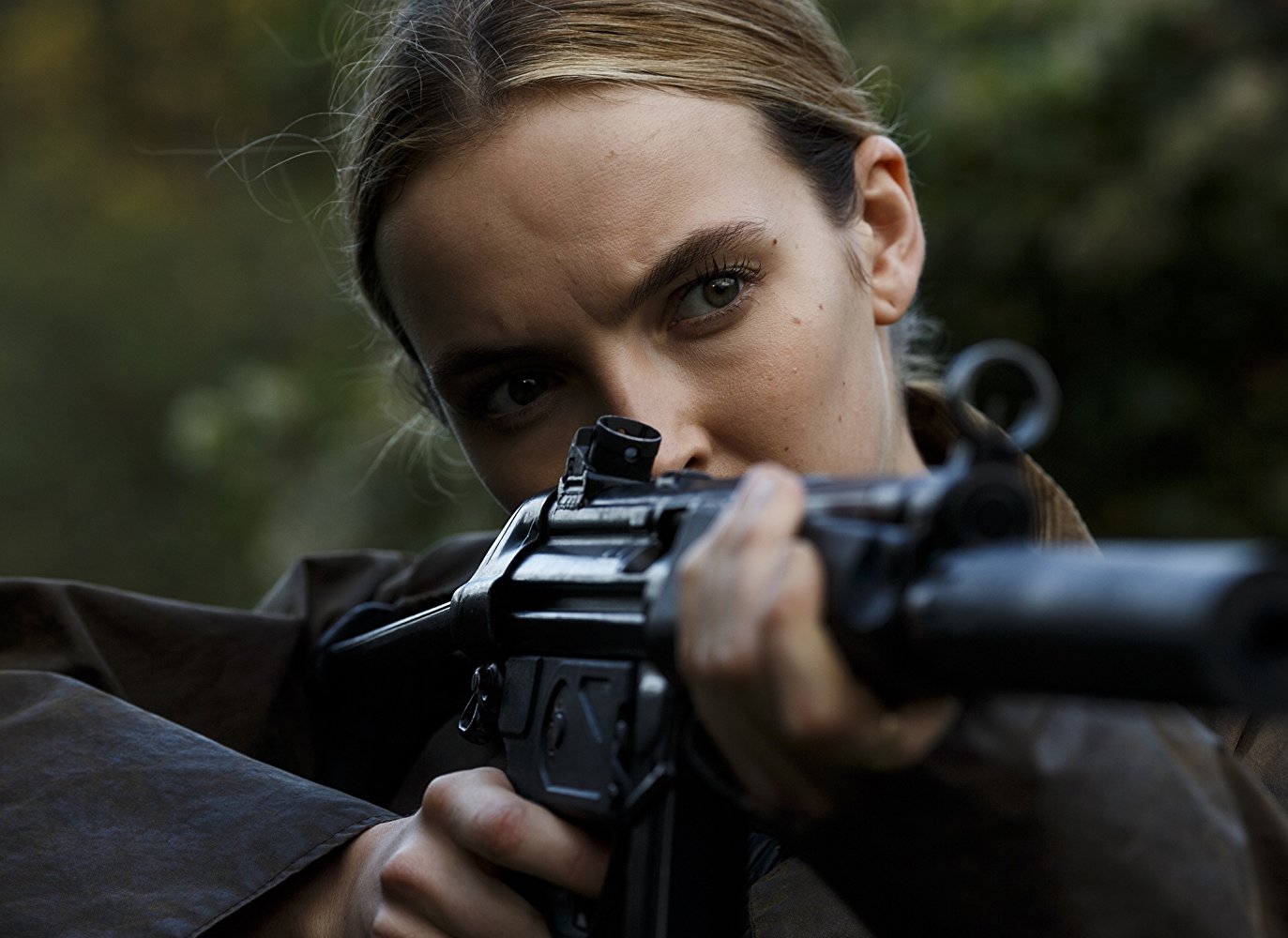 ★★★★
★★★★ A genuinely organic hit on BBC America, this generated so much word of mouth that the ratings for this show behaved in an unexpected fashion. Including those who DVR’d the show, viewership increased for each episode over its 8-week run. That’s a rare feat these days, and is testament to the show’s unique qualities. So confident were the station in the show, that is was renewed for a second season before it had even premiered – another unusual achievement. But then, this show is arguably unlike anything else on television.
A genuinely organic hit on BBC America, this generated so much word of mouth that the ratings for this show behaved in an unexpected fashion. Including those who DVR’d the show, viewership increased for each episode over its 8-week run. That’s a rare feat these days, and is testament to the show’s unique qualities. So confident were the station in the show, that is was renewed for a second season before it had even premiered – another unusual achievement. But then, this show is arguably unlike anything else on television. The show is defiantly messy in terms of its characters, who manage both to embody the stereotypes of the dogged law-enforcement official and the slick, femme fatale, while also subverting them. From the viewpoint of this site, Oksana is likely the more interesting. As a high concept, imagine a female version of Dexter: charming and affable on the surface, yet extraordinary lethal – and capable of flicking that switch in a moment. The difference is, Villanelle has chosen not to control and direct her “dark passenger” so much as embrace them fully, and is given the chance to do so by the profession into which she is recruited. It also allows her to indulge her fondness for haute couture.
The show is defiantly messy in terms of its characters, who manage both to embody the stereotypes of the dogged law-enforcement official and the slick, femme fatale, while also subverting them. From the viewpoint of this site, Oksana is likely the more interesting. As a high concept, imagine a female version of Dexter: charming and affable on the surface, yet extraordinary lethal – and capable of flicking that switch in a moment. The difference is, Villanelle has chosen not to control and direct her “dark passenger” so much as embrace them fully, and is given the chance to do so by the profession into which she is recruited. It also allows her to indulge her fondness for haute couture.